'From Private to Major via the Foresters Arms': The life, death and rediscovery of Octavius Darby-Griffith, MC
- Home
- World War I Articles
- 'From Private to Major via the Foresters Arms': The life, death and rediscovery of Octavius Darby-Griffith, MC
British visitors to the south of France will often take the A26 'Autoroute des Anglais' out of Calais. Some 140 miles down this autoroute, they will see on a prominent hill to the right the towers of the medieval cathedral at Laon. Some may turn off the autoroute to pay a visit, others will press on towards Rheims and further south.
If the opportunity to take an exit slip-road is missed, the alternative route into Rheims via the D1044 won't be available. This arrow-straight roman road (formerly the RN44) is one of those un-cluttered roads that are a pleasure to drive.
Appearing somewhat unexpectedly - and certainly unannounced - on the right, just after the turn for La Ville-aux-Bois-les-Pontavert, is a military cemetery. For drivers heading south, it is easy to pull into the lay-by and stop. I suspect this rarely happens, which is a shame.
The cemetery, officially La Ville-aux-Bois British Cemetery, contains the remains of 564 officers and men from the First World War. With only 151 identified by name, the proportion of those 'unknown' is approaching 75 percent. This seems surprising until you realise the cemetery is almost universally dedicated to those who were killed in the German offensive here that was launched in May 1918. Virtually all the headstones are from just one day - 27 May. What happened here?
The Third Battle of The Aisne
One hundred years ago, in May 1918, the Germans launched operation Blücher-Yorck which was later known to the Allies as the Third Battle of the Aisne. Although possibly not as well known as other operations forming part of the Kaiserschlacht such as 'Michael' or 'Georgette' which took place in March and April 1918, this offensive was equally devastating and - in some respects - more significant.
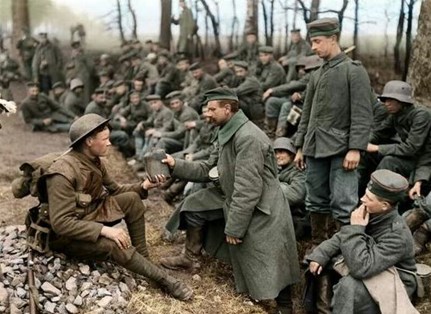
During the German Spring Offensive, one of a number of German prisoners captured at the Battle of St. Quentin is offered a flask of water by a British soldier, 22 March 1918. Source - IWM Q 10773. Colours by Toussaint Bonavita from France
Although aimed at a 'French sector' (the Chemin des Dames was well to the south of part of the front line held by British and Commonwealth troops), the attack that was launched here on 27 May 1918 swept into and through the front lines held by four British divisions. These divisions had been sent here after being heavily involved in helping to stem German attacks in March and April 1918 when they had lost thousands of men in the German 'spring offensive'. The divisions were severely depleted in the earlier battles and a 'rest' in this quiet sector was sorely needed in order to absorb and train drafts of reinforcements.
Initially, life was idyllic as the month of May warmed up. One soldier who was there described it as follows:
"To battered, battle-weary troops whose only knowledge of France was based upon their experience of the Northern front, the Champagne country in the full glory of spring was a revelation. Gone was the depressing monotony of Flanders, drab and weeping...Here all was peace. The countryside basked contentedly in the blazing sunshine. Trim villages nestled in quiet hollows beside lazy streams, and tired eyes were refreshed by the sight of rolling hills, clad with great woods golden with laburnum blossom; by the soft greenery of lush meadowland, shrubby vineyards and fields of growing corn..." [1]
Little did anyone know, that - despite the best of intentions – the men in these four divisions were now once again facing the full might of a massive German onslaught which was aimed at winning the war before the Americans arrived in strength on the Western Front. The British divisions involved here were - from left to right - the 50th (Northumbrian) Division, the 8th Division and 21st Division, together with the 25th Division, which was in reserve.
One of the British battalions that became involved in the fighting on the opening day of this battle was the 9th Battalion, Loyal North Lancashire Regiment. The 9th LNL was part of the 25th Division and had been involved in the earlier two attacks made by the Germans in the spring of 1918. Fatalities incurred in this battalion in March had been over 70, and in the first two days of the German 'Georgette' offensive (9th and 10th April) the battalion had lost over 100 killed. The battalion was involved in further fighting towards the end of April and had absorbed reinforcements to make up for the losses incurred. It seems that one of these drafts of reinforcements included Major Octavius Sidney Darby-Griffith.
22 years with the South Lancashire Regiment
Octavius Darby-Griffith was born on 2 September 1871 in Monmouth, South Wales. We know his father was Henry Christopher Darby-Griffith, a civil engineer. It has not been possible to find out anything of his early life, and the first document so far located is him enlisting (as a 'boy soldier') aged 15 years 11 months on 3 August 1887 in Portsmouth. His chosen unit was the South Lancashire Regiment. As will be explained later, he enlisted under the name Darby without the hyphenation '-Griffith'.
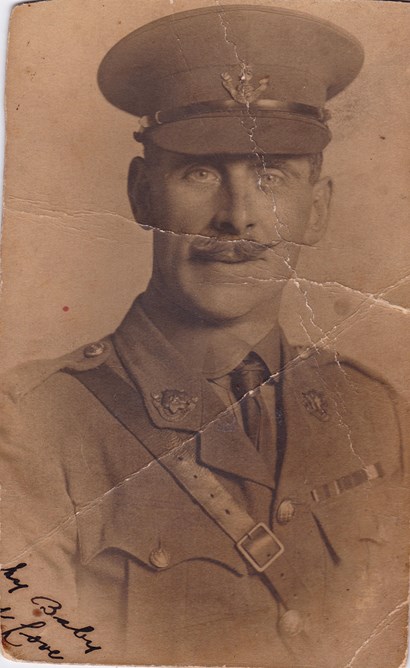
A recently located photograph of Octavius Darby-Griffith, courtesy of Phil Bedford. The photograph dates from his service with the Loyal North Lancs during the First World War
He was appointed Lance Corporal in 1892 and on 28 December 1893 he married, in Jersey, Alice Roberts, He was allowed to bring his wife onto the 'married establishment' in August 1894.
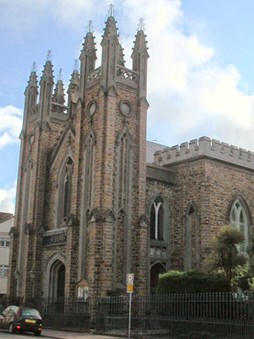
St James's Church, St Helier, Jersey
His service in the South Lancashire Regiment was initially due to last twelve years, during which time he rose to Corporal (in 1894) and Sergeant (1898). It seems that he served with his regiment in Cork, Ireland, between approximately 1896 and 1901. During his time there (in 1899) he re-engaged in order to complete 21 years with the regiment.
At some stage (unfortunately the date is illegible) he seems to have applied (unsuccessfully) for a commission. His Commanding Officer wrote a report in support of this application which reveals a great deal about Octavius. According to the report, his "manners and speech are good and he conducts himself in a quiet gentleman-like fashion". Octavius was "sober and thoroughly trustworthy" and was
"...a gentleman by birth and owing to his father's financial [illegible] and family troubles he enlisted in the South Lancs Regiment with a view to getting a [illegible, but probably 'commission']... When a corporal he was told by the late Colonel MacCarthy O'Leary...that if he could show that he had an independent income of £90 per annum he [illegible] recommend him for a commission.[The modern equivalent of this sum if in excess of £10,000]. He was unable to raise this amount and so [illegible] dropped. His grandfather was Major-General H[enry]C Darby-Griffith of the 6th Dragoons. His father is HC Darby-Griffith Esq, Civil Engineer at present in Australia. His uncle [illegible] CW Darby-Griffith late Grenadier Guards and now on reserve of officers. As his family were opposed [illegible] enlistment he enlisted under the name of Darby at their suggestion." [2]
The fact that he came from a military family may explain why, even though serving in the ranks, 21 years was not long enough for Octavius, as he was granted a further extension of his service in 1908. At this time we have a report in the local newspaper of him being warmly received for playing a flute solo (Brewer's 'Deep Blue Sea') at the Jersey Rifle club.
Two years later, in 1910 Octavius was eventually discharged from the regiment in Jersey with an 'exemplary' record. He had completed nearly 23 years service. At the time of his discharge he was attached to the permanent staff of the 2nd Royal Militia, Island of Jersey. His discharge papers tell us he intended to be a hotelier at the Forester's Arms at Beaumont (some three miles outside St Helier). The census of 1911 records Octavius Darby-Griffith (aged 38) living at the Foresters Arms with his wife Alice and daughters Rose (15) who was 'assisting in the business', Alice (14) and Helena (10). Tragically a fourth daughter, Violet, had died in childhood.
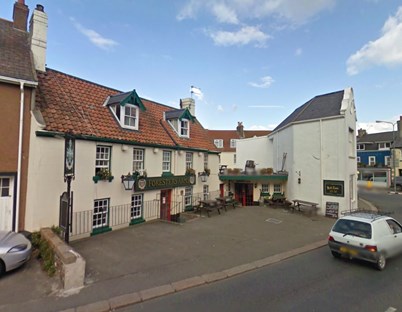
The Forester's Arms at Beaumont, St Helier
Outbreak of War
Although approaching his 43rd birthday, his service 'in the ranks' of the South Lancashire Regiment from seems to have enabled him to successfully return to the Army on the outbreak of war. He was appointed to a temporary commission as 'Honorary' Lieutenant as a quartermaster in the 7th Loyal North Lancashire Regiment. Presumably he would have preferred to have rejoined the South Lancashire Regiment, but no doubt he was simply happy to be back in the army. It is certain that his pre-war experience would have been needed in this 'K2' battalion. Promotion to Captain followed (a London Gazette notice was published stating that he was at the time in the 7th Battalion as a temporary Quartermaster and Honorary Lieutenant, but to be promoted to temporary Captain with effect from 26th November 1914). Clearly his age did not prevent his appointment to a combat role.
Records are unclear and contradictory at this stage, and there are two alternative narratives for his service in 1915. The suggestion from his file is that he joined the 7th LNL in April 1915, and was wounded in mid May forcing his return to return to England, however this can't be the case as the 7th Battalion was not despatched to France until July 1915, and no trace of his joining a battalion can be found in any war diaries. The same note in his file suggests a further period of service with the 7th Battalion from 24 July until being wounded two months later in September. Whilst this is possible, there is no reference to him on the strength of the battalion in this period. Going by this document it suggests he returned to the 7th Battalion in France at the end of October.[3]
Somme and beyond
Despite the uncertainty of his movements in 1915, there is no doubt about his front-line service in 1916. From both documents in his file and the battalion's war diary, it can be seen that he arrived with the 9th Loyal North Lancs (part of the 25th Division) on 28 June 1916, joining 'D' Company of the battalion. By this time the 9th Battalion had been on the western front for nine months.
Octavius's arrival was unfortunately timed, as this was the eve of the Battle of the Somme and his battalion, along with the rest of the 25th Division, was soon in the thick of the action, being sent into the trenches at La Boisselle on 5 July and going into action two days later.
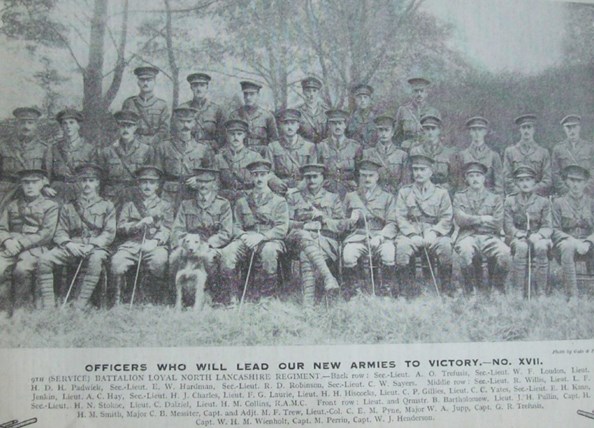
Above left - Officers of the 9th Loyal North Lancs. Although he is not included in the photograph, Octavius would have known most of the officers of battalion, which arrived in France in September 1915. From the foliage and the fact that John Pullin is present (killed in January 1916), it is likely the photograph was taken in the summer of 1915. Of the 29 officers named here we know that at least six were killed in the war. Those killed are as follows:
AO Trefusis 7/7/16; RD Robinson 7/6/17; R Willis 15/5/16; CC Yates 16/5/16; JH Pullin 21/1/16; WJ Henderson 6/7/16
Image courtesy of Paul McCormick / www.loyalregiment.com
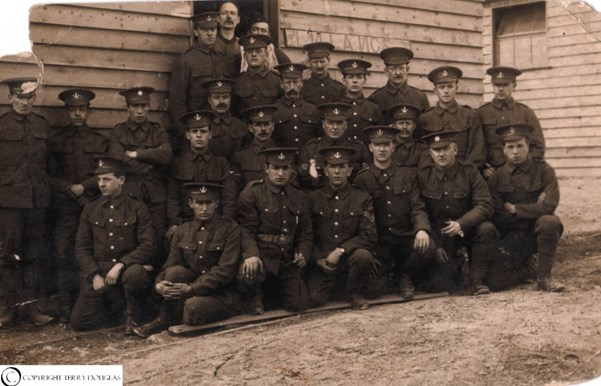
Above : A group of NCOs and men of the 9th Loyal North Lancs. On the hut behind is written 9th L.N.LANCS. Image courtesy of Paul McCormick / www.loyalregiment.com
August 1916 found the battalion in the Thiepval area. It is possible that during this time he may have bumped into JRR Tolkien who was an officer in the 11th Lancashire Fusiliers , a battalion which was in the same brigade (74th) as the 9th Loyal North Lancs. Tolkien is said to have based his Lord of the Rings books on his experiences around the Ancre Valley.
Octavius was taken ill and admitted to hospital on 31 August with Pyrexia (his file refers to him being sent to the 7th Stationary Hospital with 'Trench Fever'). He was home on sick leave in September and recovered quickly enough to rejoin his company on 5th October, but just seven days later was wounded in his right shoulder and buried by a shell explosion. He was back in hospital to be treated for his wounds and for shell shock, arriving in England on 19th October 1916.
It was to be some nine months later that he was passed fit, going back out to France on 15 July 1917. After a few days at the Infantry Base Depot at Etaples, he joined the 1st Battalion of the LNL on 21 July. There is no record in the battalion's war diary detailing any of his activities, but it is clear that the battalion was undertaking extensive training for the planned (but never undertaken) Operation Hush on the Belgian coast. This involved practising for an amphibious attack behind the German lines as part of the supposed breakthrough after the Third Battle of Ypres. There is a reference within the battalion's war diary of Field Marshal Sir Douglas Haig inspecting the 1st LNL as they were selected to demonstrate how they would scale the sea wall. Haig, according to the war diary appeared "well pleased with the performance".[4]
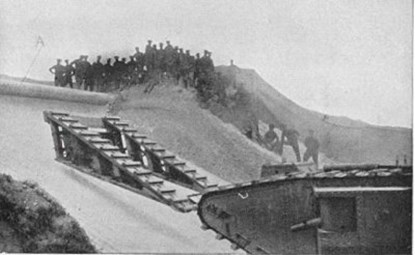
Tanks in training for scaling the coastal sea wall. Image courtesy of www.longlongtrail.co.uk
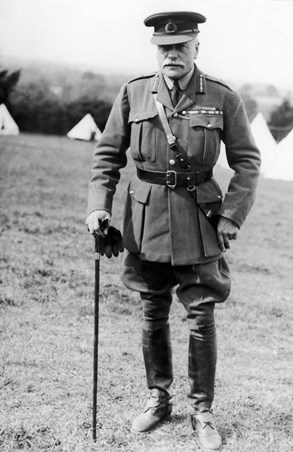
Field Marshal Sir Douglas Haig
Senior Officers Course and promotion
Octavius enjoyed 16 days home leave in late November and early December 1917, subsequently rejoining the 1st Battalion for a short period before being sent to Aldershot on a Senior Officers Course in early January 1918. This course seems to have lasted three months. During the course he learned he had been awarded the Military Cross.
The citation for the award of the Military Cross reads:
"For conspicuous gallantry and devotion to duty when in command of a company which took over a sector of the line after an unsuccessful attack. He quickly reorganised the line, which contained large gaps, and steadied his men under constant shell fire. When, after being relieved, two of his platoons were caught by an enemy barrage he distributed them in shell holes, and by working from shell hole to shell hole, got them clear without many casualties. After getting them clear he returned through the barrage and attended to his wounded, remaining with them till the last had been evacuated."
(Unfortunately it has not yet been possible to identify the action he was involved in when this was awarded.)
After he completed his Senior Officers Course, it can be assumed that he would have seen his wife Alice and family before departing to France for the final time. Octavius rejoined the 1st LNL on 6 April 1918 but within three days was sent to the 66th Division and assumed command of the 2/6th Battalion Manchester Regiment. A telegram back home to Alice at 169 Fox Lane, Palmers Green dated 12 April reads "Have got command writing you - am well".
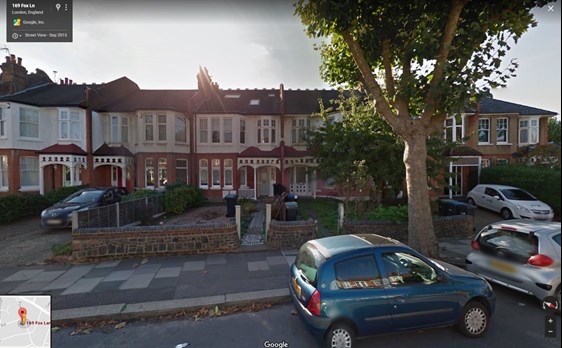
Fox Lane, Palmers Green
Although he may have been promoted to the command of an infantry battalion, this particular unit had been badly damaged during the German Spring offensive of March 1918 and had been reduced to a training cadre. This non-operational command was not to last long as he was posted to back to the Loyal North Lancs and rejoined the 9th Battalion which was still part of the 25th Division and serving at the time north of the Ypres salient. This was in the "Dirty Bucket" area near Elverdinghe.
He was probably happy to be back among old faces he knew from the Somme, although no doubt there would have been many gaps around the mess table after 18 months away from the battalion. The London Gazette entry dates this appointment to the 9th Battalion as taking place on 24 April, and states that Temporary Captain OS Dary-Griffith, MC to be acting Major whilst employed as 2nd in Command of (the unspecified) Service Battalion. He was no doubt pleased that he was now second in command of a front line battalion, and an acting Major. The unit's war diary records his arrival - although not by name - on either 22nd (“two officers joined from base”) or 23rd April (“twelve officers joined from base”). Such an influx of officers suggests the battalion was seriously under-strength. It would have been difficult to assimilate these reinforcements and this was exacerbated by the operations the battalion was about to undertake.
Within a few days the 9th battalion moved a few miles to the south and Octavius Darby-Griffith was to take operational command during the next few days of fighting.
At 3am on 26 April, 18 officers and 402 Other ranks attacked towards Kemmel village. They consolidated the line taken on 27 April but Octavius was wounded and taken back to the transport lines on the 28th. This seems not to have been a serious wound, as he remained with the battalion.
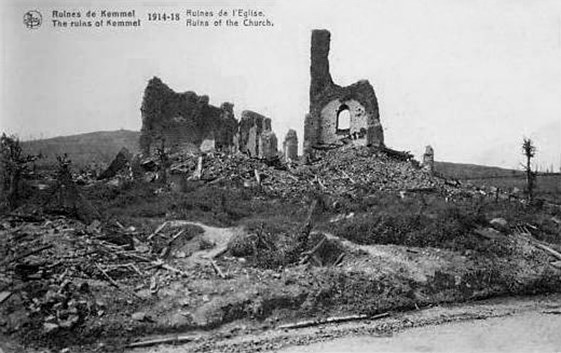
A French postcard labelled 'The ruins of Kemmel'
A few days later Octavius was still in command of the battalion 'in the line' as Major Nares (the battalion commander) was with the transport. It seems the battalion was heavily shelled on 5th May just as they were coming out of the line. The war diary describes how the four companies of the battalion were relieved between 1.30am and 3.30am but the Commanding Officer of the incoming battalion did not arrive until 5.15am ...
"when the enemy opened a barrage of HE and gas. Major OS Darby-Griffith MC who was commanding, and the acting adjutant Captain WF Loudon MC took refuge in a shell hole with four orderlies until 8am and then proceeded to join the battalion."
The period between 26 and 29 April resulted in 27 fatalities to the battalion, with no doubt many others wounded.
To The Aisne
It was at this stage that the 25th Division was sent to the quiet sector of the Chemin des Dames in order to rest, and to absorb and train reinforcements. The train journey to the Chemin des Dames took place between 10th and 11th May, and the battalion arrived at Fère-en-Tardenois where they were inspected by the GOC of the 25th Division, Maj-Gen Bainbridge.

Major-General Sir Guy Bainbridge
The 14th May saw Major (acting Lt-Col) EP Nanes leave the battalion to go to the 66th Division HQ. He was replaced as commanding officer by Lt Col Archibald Tringham DSO.
Tringham was not in command of the battalion for very long, just seven days later, on 21 May he left for the 75th Brigade HQ. This meant that Octavius was now in command of the battalion. On 23 May the 9th LNL moved to Vandeuil a village just south west of Jonchery-sur-Vesle. The war diary records a CO's inspection of the battalion on 25 May and church parades on the 26th.
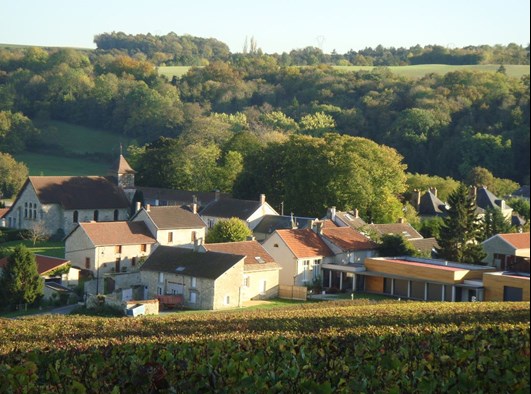
Above: Vandeuil village
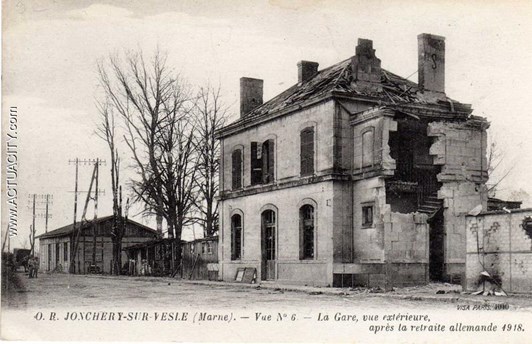
Above - a postcard of Jonchery-sur-Vesle railway station 'after the German retreat 1918'
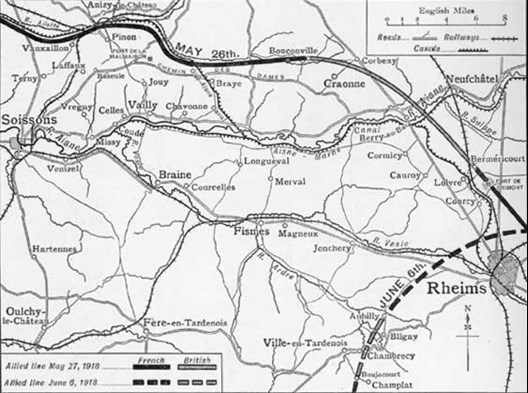
Above: The area between Soissons and Rheims - which came under German attack in late May 1918
The attack launched by the Germans on 27 May was devastating for the front line units. On the left the 50th (Northumbrian) Division was holding high ground on the eastern edge of the Chemin des Dames ridge. There is not scope within this article to detail the German attack or the reasons for the breakthrough, but much of the blame has been laid at the door of French generals who refused to listen to British advice about the disposition of forces.[5] The British units - particularly the 50th Division and the 8th Division to their right - ended up being trapped in the flat area between the ridge and the River Aisne. Desperate fighting took place but many troops from these divisions were killed or captured. It is within this context that the 25th Division was ordered forward by the British Corps commander, Lt Gen Alexander Hamilton-Gordon who had been unable to order changes to dispositions due to French intransigence.
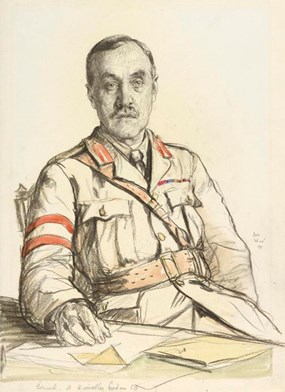
Sir Alexander Hamilton Gordon (1859-1939), known (ironically) as 'Sunny Jim' on account of his melancholy demeanour, served as commander of IX Corps from 1916 until his dismissal in September 1918
Eventually, at 7.30am, the 25th Division was instructed to send each of its infantry brigades forward to support the three divisions which had been holding the front line. As a result the 74th Brigade (containing the 9th LNL as well as the 3rd Worcesters and the 11th Lancashire Fusiliers) was ordered to move up in support of the 50th Division, which by this time were being forced back across the River Aisne.
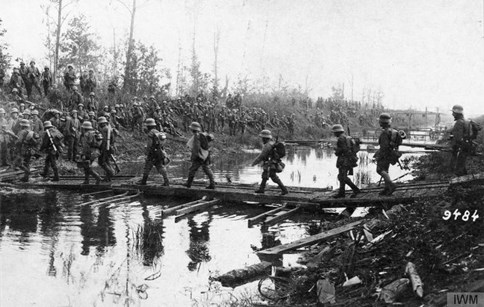
The morning of the first day of the Battle of the Chemin des Dames, 27 May 1918. German troops crossing a canal and awaiting orders to continue the advance. Imperial War Museum image Q88094
The 9th LNL's war diary details what happened on 27 May:
At 9am, one platoon per company was ordered forward to a line along the Canal Bank at Maizy to form a nucleus of defence.
At 12noon the commander of the Battalion [Octavius] was ordered to reinforce at once the line already taken up. Total going into action 18 officers and 496 other ranks. Capt WF Loudon, MC -wounded; Lt A Summer - wounded; Capt RR Shields, MC - wounded and missing; 2/Lt AE Downing wounded and missing [6]; Major OS Darby-Griffith MC killed; 2/Lt JBM Lightbody - wounded.
Major Lloyd 105th RE assumed command of Battalion.
On 28 May 5 officers and 72 other ranks reported at transport lines in small parties during the day (remnants of Battalion). Capt WS Hartley assumed command of battalion at transport lines.
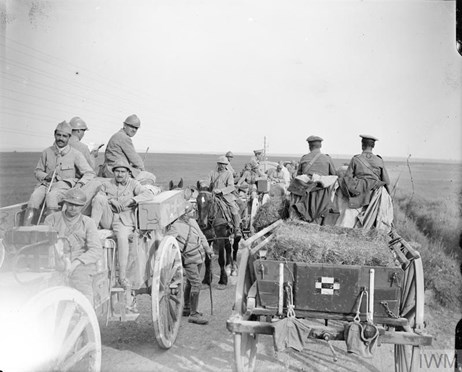
The Third Battle of the Aisne. French and British (25th Division) horse transport passing on the road. Passy-sur-Marne, 28 May 1918. IWM Q6674
News of the attack broke back home, but it may well have been some days before Alice learned of the death of her husband. There is a telegram within his file at The National Archives dated 4 June which seems to be the official notification of his death.

News of the Battle as reported in a US newspaper.
From reviewing the CWGC records, we know the battalion incurred 48 fatalities on this day including two officers: one of these was Octavius. A further six fatalities were incurred on the 28th May. Only two of the fatalities from the 27th have known graves, all the rest are named on the Soissons Memorial to the Missing.
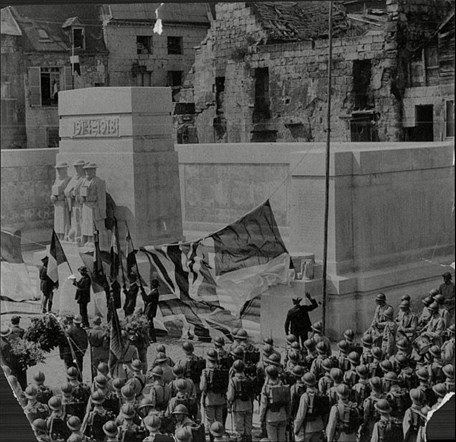
The Soissons Memorial being unveiled on 22 July 1928 by Sir Alexander Hamilton-Gordon. Note the damaged buildings behind the memorial.
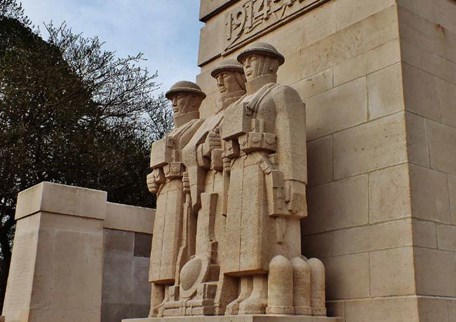
A close up of the detail of the Soissons Memorial. Image courtesy of Mark Allen / WFA Calendar 2018
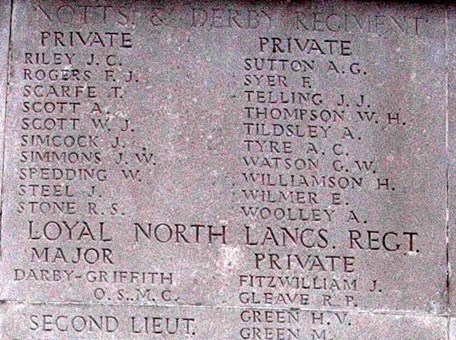
Detail from the Soissons Memorial, showing OS Darby-Griffith of the Loyal North Lancashire Regiment
A little more is known about Octavius on this fateful day. Within his file at The National Archives is a copy of a letter from Joseph Duckworth dated 8 March 1919.[7] This is obviously answering an enquiry made by Alice, Octavius's wife. Duckworth says "He [Darby-Griffith] was stood beside me giving orders to his men to extend, as the Germans were advancing on us and he was shot through the heart, and buried the same day just behind Maizy."
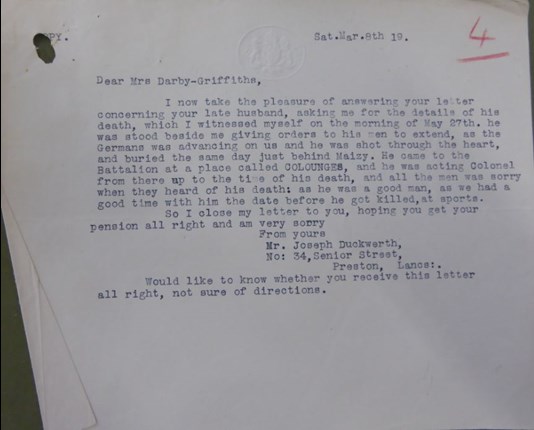
A transcript of Joseph Duckworth's letter.
* * *
A few years ago, on a visit to the area, my wife and I visited the CWGC cemetery at La Ville-aux-Bois, some eight miles to the north-east of Maizy. Wandering around the cemetery, we noticed a headstone stating 'unknown Major, Loyal North Lancashire Regiment'. Realising there would be few battalions of the regiment operating in the area, and that few men with the rank of Major would have been killed, it seemed that it should be possible to identify this officer.
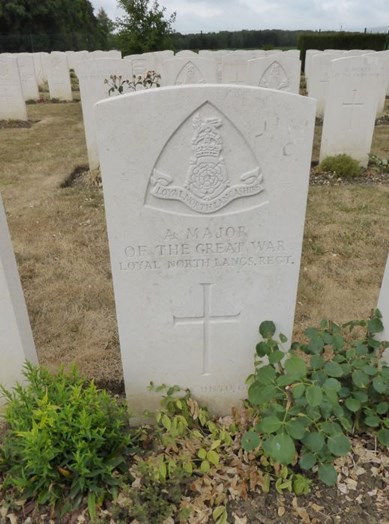
The headstone of the 'unknown Major, Loyal North Lancs Regiment at La Ville-aux-Bois British Cemetery
It was easy to verify that there was really only one candidate who could be buried in this grave, due to the fact that only one battalion of the Loyal North Lancs was in the area, and only one officer of this rank was killed - being Octavius Darby-Griffith.
Gathering further evidence took some time. An early - and vital - piece of evidence was the 'Concentration of Graves (exhumations and re-burials) Burial Return' dated 15 June 1920 available on the CWGC web site. This showed that the grave now in La Ville-aux-Bois British Cemetery had been exhumed from (map reference) 293.2 x 210.4. (There were a number of men from this row originally buried at, or near this map reference). With the help of Howard Anderson, a member of The Western Front Association who is an expert on the subject of maps, it was possible to match the map reference of the location of the original grave with the known position of the 9th LNL on 27th May.
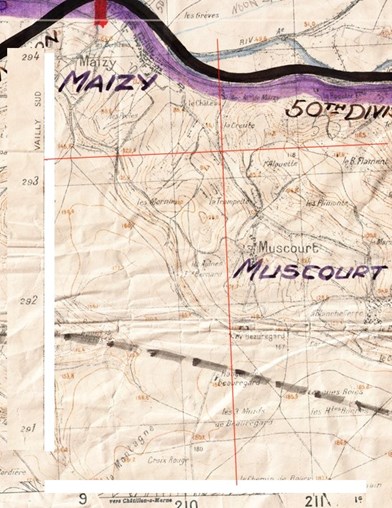
Extract of the map provided by Howard Anderson. The red horizontal and vertical lines show the location of the map reference provided in the exhumation report
Looking at the burial return, it could be seen that many of the burials concentrated into this plot at La Ville-aux-Bois were "unknown", and the inscription on many of the original grave markers showed that a number of these had been buried by the Germans. The exhumation party noted on the documentation they prepared that the body of the 'unknown Major' who had been located was bearing clothing, rank badges and (medal) ribbons.
What seems not to have been taken into consideration (perhaps it was not reported to the exhumation party or the Imperial War Graves Commission) was that a silver identity disc bearing Octavius's name had been found on the original grave. Although this was reported to the War Office by the 'Mission for Tracing British Officers' in a letter dated 19 June 1920, clearly this was not taken into account when the re-burial took place at La Ville-aux-Bois. This omission seems to have ensured the body was not identified by name at the time.
After presenting the evidence of the 'unknown Major' being Octavius to the CWGC, the case was in turn passed to the Joint Casualty and Compassionate Centre (JCCC), part of the Ministry of Defence which confirms the identities of those found and traces surviving relatives. They agreed with the assertion that the 'unknown Major' buried at La Ville-aux-Bois was Octavius Darby-Griffith and that the headstone to the 'unknown Major' would be replaced with one bearing Octavius's details.
There will be a ceremony to mark this on 30th May 2018. At the graveside, besides representatives from the regiment will be descendants of Octavius Darby-Griffith.
Aftermath
Octavius's story does not end with his death near the River Aisne in 1918. Within his file at The National Archives is a series of letters from his widow Alice who it will be remembered he had married twenty four years previously just after Christmas 1893 at St Helier in Jersey. This correspondence between Alice and the Ministry of Pensions continued into 1921.
The first letter from Alice is dated 13 December 1918, and in this she is chasing up a clearly slow and bureaucratic Ministry of Pensions. Nothing seems to have been resulted from this as she wrote again on 28 January 1919 and again on 10 February 1919 asking how long it would be before the grant was paid to her. Eventually it was paid and amounted to £279 (approximately £15,000 in today's money).
A further series of correspondence took place later, written from 35 Cheriton Road, Folkestone. Alice refers to her husband being wounded five times (this suggests his 1915 service when he was wounded twice is correct) and that he was acting Lieutenant-Colonel when killed. The problem that Alice faced was that the Ministry of Pensions had made an award based on a Major's pension only and, Alice believed, that as Octavius was commanding a battalion and was, or likely, to be promoted to Lieutenant-Colonel she would be entitled to a higher pension. Alice said,
"Just the difference of a Colonel's Widows Pension would make all the difference to my position in life now, it is hard to me to have to start looking for an appointment now at my time of life [she was 49 years old]...My Major's pension cannot cope with all, hence, I shall have to give up housekeeping and seek employment of some kind..."
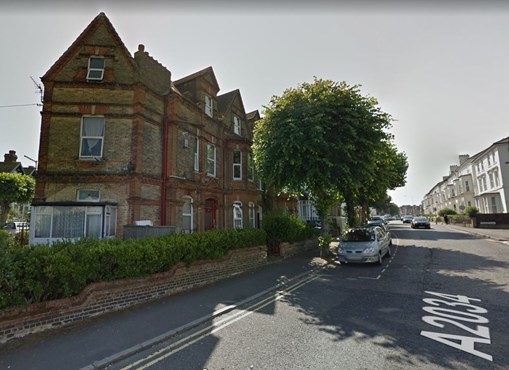
35 Cheriton Road, Folkestone
Despite obtaining the support of Lt-General Hugh Craigie Halkett who in 1918 was the brigade commander in which the 9th Loyal North Lancs served, she could not persuade the Ministry of Pensions to award her a higher allowance. Craigie Halkett tried his best by certifying that Octavius was acting Lieutenant-Colonel and would have been confirmed in the rank had he not been killed, but it seems that the ministry would not budge on the issue.
Although from a well-known military family, the financial problems that had fallen on his father which had resulted in Octavius enlisting as a private, continued to have an impact even after his death, and despite serving so many years with the army, his widow seems to have been denied a higher pension due to the strict application of the regulations.
Alice lived out her days on the south coast of England, living at one stage with her daughter Rose in a flat in Buckingham Road in Brighton. Alice died in 1947.
The daughters of Octavius and Alice had families of their own and probably handed down a small number of family anecdotes about the death of Octavius.
Due to the diligent investigation of the JCCC, some of the family of Octavius’s youngest surviving daughter, Helena, were traced. They are delighted that, for the first time in 100 years Major Darby-Griffith will have a ‘known’ grave.
Article by David Tattersfield, Vice-Chairman, The Western Front Association. May 2018
With an introduction from The WFA this is the piece transmitted BBC Jersey.
Notes
[1] Sidney Rogerson, The Last of the Ebb. The Battle of the Aisne, 1918 (London: Arthur Baker, 1937), p.4
[2] The reference to MacCarthy O'Leary is interesting. It appears that, in August 1888, he was posted to the 1st Battalion South Lancashire Regiment, then at Portsmouth, and with them he served in Jersey, and at several stations in Ireland. In November, 1888, he was appointed to the command of the battalion, and in autumn of 1898 he took his corps to the manoeuvres at Salisbury Plain, where he was highly complimented on the efficiency and smart appearance of his men, and upon the skilful manner in which he handled them. Though one of the tallest men in the army, he was also the most active, and it was largely due to his encouragement of sport that the 1st South Lancashire had established such a reputation for themselves as cricket and football players, in both of which games they excelled.
[3] The alternative to this narrative for 1915 is that he joined the 11th Battalion, Loyal North Lancs, which was a second reserve battalion. This makes sense in so far as he would have been a valuable officer to employ training recruits.
[4] The National Archives (TNA): Public Record Office (PRO) WO95/1270: War Diary of the 1st Battalion, Loyal North Lancashire Regiment.
[5] For an excellent overview of the battle, see David Blanchard, Aisne 1918 (Barnsley: Pen and Sword Books Ltd, 2015)
[6] Downing was later declared to have been killed and is commemorated on the Soissons Memorial
[7] The National Archives (TNA): Public Record Office (PRO) WO339/11468: Officers file of OS Darby-Griffith





